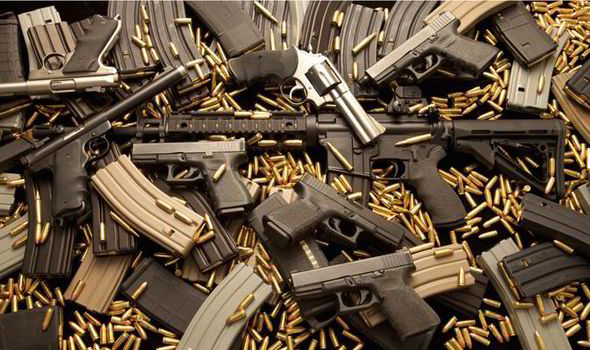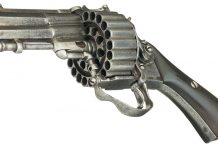If you want to get a debate going amongst survival types, all you have to do is say, “The best survival gun is _____.” It really doesn’t matter what type of gun you fill in the blank there, you could say a Kentucky Long Rifle or a Blunderbuss. Regardless of what it is, you’ll get a whole bunch of people responding, telling you why your choice is wrong and their favorite gun is the survival gun of choice.
Part of the problem is that there really is no one perfect gun for survival; I don’t care what you pick. Survival needs are so varied, that there really isn’t one gun that will do everything you need. If you’re serious about survival, you need a small arsenal of personal firearms, picking out the best possible gun for each specific purpose.
By the way, that small arsenal I mentioned is a small arsenal for each shooter in your survival team. Unless each member of your team only has one job to do, they’re probably going to need multiple types of guns.
Of course, if you bug out, you’re not going to be able to take the whole arsenal with you. In that case, you’re going to have to limit it to one long gun (rifle or shotgun) and one sidearm per person. It’s not just the weight of the guns you have to consider, but the weight of the ammunition as well.
One way to handle this is to arm your bug out survival team with a variety of different long guns. This will allow you to have that same sort of variety that your personal arsenal gives you, while limiting the weight that each person has to carry. If you standardize a bit on the guns you all buy, then you should all be accustomed to shooting the same guns, meaning that you can switch guns back and forth between you, without a whole lot of problem.
That still leaves us with the problem of what guns to buy. Basically, that means guns for:
- Personal defense (pistols)
- Home or survival retreat defense
- Team defense on a bug out
- Hunting big game
- Hunting small game
- Hunting birds
Let’s take a look at some of the best out there. You might not agree with me about some of these choices and you have a right to your opinion. But these are some of the best I see out there. I’ve purposely avoided all fully-automatic firearms, because I don’t feel they are practical for a survival situation. You would go through too much ammunition, too quickly.
Pistols
I’m personally a fan of semi-automatics, rather than revolvers. Yes, I know that revolvers are simpler and less likely to break. But if I’m depending on a pistol for my life, I want to have the most firepower possible. I just don’t like the idea of being limited to six rounds. While there are speed loaders out there, I have only met one former police officer who can actually load a revolver as fast with a speed loader, as the average shooter can slap a fresh magazine into a semi-automatic.
There’s also a lot of discussion out there about caliber. Personally, I’m a .45 fan, probably because that’s what I learned to shoot in the Army. But my survival gun is a 9mm. This is the single most popular caliber in the world, meaning that it is the one which will be most likely to be available for barter. So, while I carry a .45 every day, I also have a 9mm for my survival sidearm.
Glock Model 19
Glocks are probably one of the most popular pistols on the market; largely due to the ease of customization. All Glocks are basically the same, regardless of the caliber of frame size. That makes it extremely easy for aftermarket parts companies to produce parts for them. Their wide use in the law-enforcement community gives them enough of a market to make it profitable to do so.
The model 19 is their compact 9mm version, a slightly smaller version of the model 17. While carrying two rounds less in the magazine, the double-stack design still allows for 15 rounds, a very respectable load. Yet at the same time, the model 19 is smaller, lighter and easier to conceal than the model 17.
Smith & Wesson M&P Shield
The Smith & Wesson M&P is one of the top-selling pistols in the USA today. This is largely due to its compact size and light weight. This single-stack pistol is great as a concealable gun, making it ideal for everyday carry. In a survival situation, it might be an ideal backup gun, hidden away in case the primary is lost or taken from you.
Even though this is a subcompact semi-automatic pistol, it has s solid trigger. The standard magazine gives you a 7 round capacity, as opposed to most concealable guns, which only hold 6. That one extra round is a big advantage and has contributed considerably to the M&P’s popularity.
SigSauer P320
The SigSauer P320 has just recently been adopted by the US Military as the new sidearm, replacing the Beretta M9, which was the sidearm from 1985 to present times. Like the Glock, the Sig is a highly modular design, which we can expect to see a lot of aftermarket parts coming out for.
Having owned a SigSauer, I can testify to their reliability and ease of use. One of the things that has made this particular model so popular, and which won it the military contract, is that three different grip modules can be used with it, allowing it to accommodate different sizes of hands.
Colt 1911
I can’t let this list go without at least one pistol which isn’t a 9mm. There’s a good reason why the venerable Colt 1911 was the military sidearm for an amazing 74 years; that’s because it is so effective. Invented by James Browning, this pistol was created with the idea of combating Moro tribesmen, who would come out of the jungle high on drugs. The larger diameter and rather blunt .45 ACP round was excellent at transferring its energy into these tribesmen, increasing the chance of knocking them down, even if they didn’t feel the hit.
There are so many 1911s in circulation, that you can find a wide variety of aftermarket parts for them, just like Glocks. In fact, it almost seems like it’s hard to find a 1911 which hasn’t been modified, even if that only means changing the grips.
Rifles
The main gun for most people will of necessity be a rifle of some sort. The question then is, what sort of rifle. That can be a bit difficult to decide, as the same rifle might have to be used for multiple purposes. A rifle which works for hunting really isn’t all that good for home defense. One that is good for hunting big game, will splatter small game all over the landscape. So how to pick?
As with the pistols, I’d stick with the most popular rifle calibers out there; that’s 5.56mm/.223 caliber and 7.62mm/.308 caliber. While there are a lot of other good hunting calibers out there, like the .30-30 and .30-06, those calibers don’t work for tactical rifles. So, not only will they probably be harder to find in a post-disaster world, but you’ll have to stock more calibers of ammunition.
Once again, I would go with more than one rifle; perhaps a tactical rifle and a hunting rifle. That would give me more flexibility. If an AR-15, chambered in 5.56mm/.223 caliber is the tactical rifle, then a .22LR kit will allow it to be used for hunting small game as well.
On the other hand, an AR-15, chambered in 5.56mm/.223 caliber really isn’t a good hunting round for big game. You’re much better off with a 7.62mm/.308 caliber, or the other hunting calibers I mentioned above. A lot will depend on your team picks to standardize on and how you go about stockpiling your ammo.
Some people claim that a .22LR is an ideal survival rifle and there are even a couple of collapsible .22LR survival guns on the market. But you’re limited in what you can do with any .22LR. While good for shooting small game, that’s really all they are good for. Granted, if that’s all you have for self-defense, you use it; but why would you want to set yourself up that way?
AR-15
The AR-15 is inarguably the most popular sporting rifle in the country today. There are a number of things which contribute to this, but probably the flexibility and customizability of the design are the main reasons. You can literally do just about anything with this platform, setting it up for just about any purpose. I’m not even going to try and pick a specific AR-15 model as the best, as there are so many of them out there. Mine is custom made, as are many others.
Because of its capability, the AR-15 has also become the number one rifle for most preppers. If you need a rifle for defensive purposes, this will do much better than the hunting rifles mentioned further down. But the standard 5.56mm/.223 caliber cartridge really isn’t heavy enough for big game hunting.
Nevertheless, I’d recommend that everyone have an AR-15 in their personal arsenal, along with plenty of extra magazines. I’d also recommend buying one that is chambered in the standard 5.56mm, rather than something larger. As a defensive round, the 5.56mm is excellent. You can also use this gun for varmints and hunting small game, especially if you get the .22LR conversion kit I mentioned earlier.
AR-10
The AR-10 was actually the predecessor to the AR-15, chambered in the larger 7.62mm. While it was off the market for a lot of years, it has become more popular in recent times. Basically, it offers you everything the AR-15 does, in a larger caliber. This gives you the advantage of being able to use it for hunting large game.
AK-47
There are those who prefer the Soviet Union’s AK-47 over the AR-15. I’m personally a bit prejudiced against them; but that’s due to my time in the Army. The AK-47 is an excellent rifle, as proven out by how popular it is, around the world.
One of the greatest advantages the AK-47 has over any other rifle on the market is that it is virtually indestructible. You can take an AK-47 underwater or in a mud puddle and fire it, without damaging the gun in any way. There are few other guns around that you can do that to. Designed for simplicity and ruggedness, the AK-47 could actually be the ideal survival rifle, as it would probably last forever.
Chambered for the 7.62mm round, the AK can be used for hunting big game, unlike the standard AR-15. This is an advantage too. Having a rifle that works for both defensive purposes and hunting, all in one package, is ideal for survival.
Remington 700
The Remington 700 series of rifles has been a favorite of hunters for many years. It’s also made itself quite a reputation as a sniper rifle in the US Army. While we now have other sniper rifles which are much higher caliber and have much longer ranges, there’s no doubting the quality and reliability of the 700.
My personal Remington 700 is chambered in .308 caliber/7.62mm, in the belief that this will be easier caliber ammunition to find. I’ve customized mine, putting a MagPul tactical stock on it and a bi-pod. I’ve also put the magazine well in it, so that I can change magazines quickly and easily. You have to buy one that’s made for this, or you can’t do that modification. While my 700 is intended to be a hunting rifle, the mods I’ve made make it possible to use it as a sniper rifle, if I should so need.
Mauser M18
Mauser has quite a reputation for rifles, especially bolt-action ones. It comes from the factory chambered in 3.08, with a detachable magazine and an adjustable trigger. This is nice, as it allows you to lighten up the trigger pull for more accurate shooting. The three-stage safety allows you to carry the rifle with a round in the chamber, without having to worry about it being forced to go off.
This rifle is filled with convenient features, like a storage chamber in the stock; a great place to keep your cleaning supplies. If you think about that, it’s a great idea for a survival gun. It’s also got a fairly short barrel, making it ideal as a brush gun.
Browning X-Bolt Hunter
This browning comes with a detachable rotary magazine, which I consider a necessity for a survival rifle. But what makes it really special is the way it handles recoil. The “recoil index technology” used in its design pushes the stock down and away from the shooter’s face. Like the Mauser, the trigger is adjustable, with a low end of just 3 pounds.
While I expect Brownings to have excellent design, they didn’t miss a thing on this one. The barrel is free-floating, which increases accuracy, especially when making multiple shots over long distances. On top of that, the ergonomics are outstanding, making it a very easy rifle to work with.
Shotguns
When we talk shotguns in the prepping and survival community, we’re talking 12 gauge; so let’s get that out of the way to start with. I’m not even going to think about 20 gauge or .410.
In many ways, the shotgun is the ideal survival firearm, mostly due to its flexibility. The shotgun has two primary purposes in survival, just like the rifle, hunting and defense. But the thing is, you can hunt for just about anything with a shotgun, out to about 100 yards, just by changing the type of ammunition you are using. Small game can be hunted with the same rounds as birds, slugs can be used for big game and a combination of buckshot and slugs can be used in defensive situations.
Shotguns can be broken down into two basic groups: tactical shotguns and hunting shotguns. There are two basic differences between these two. The first is barrel length, the average tactical shotgun barrel is only 18.5 inches, while the average hunting barrel is 26 to 25 inches. The other is the number of rounds they hold in the magazine. Hunting shotguns are generally limited to three rounds, while tactical shotguns can hold three, five or seven. Some even have replaceable magazines.
While tactical shotguns really aren’t designed for hunting, especially bird hunting, I think they could still be useful for hunting in a survival situation. The key is the choke. Most tactical shotguns are “full bore” meaning that the muzzle doesn’t close in any, providing a “choke.” But that’s not to say they can’t be.
Not only that, but the chokes on some shotguns can be changed. So, if you have a tactical shotgun with interchangeable chokes, you could leave it full bore for tactical uses, then change it to “full choke” to get a tighter pattern for hunting. It wouldn’t be quite as good as a hunting shotgun, but it would be acceptable. Just don’t try running a slug down that barrel with full choke.
Kel-Tek KSG
I was very impressed the first time I saw Kel-Tek’s SKG. This is a dual-magazine, bullpup shotgun, designed specifically for building clearing and other CQB applications. Each magazine holds 7 rounds, giving you a total capacity of 15. One magazine could be filled with slugs and the other buckshot, allowing you to switch easily between the two. The only thing wrong with it is that the magazines aren’t removable, so it takes a bit of time to reload it.
In my opinion, this is the best possible firearm for home defense, providing a lot of firepower in a compact, easy to use design. If I had to defend my home from a gang of attackers, this is what I would want to use. However, I’d want my AR-15 standing by, in case I needed more than the 15 rounds it holds.
Another great use for the KSG is the slack man when on patrol. This is the backup person for the point man. Their job is to protect the point man, in case he comes under fire. As such, they need a lot of firepower that they can throw out there, quickly.
UTAS UTS-15
The UTAS UTS-15 is very similar to the Kel-Tek SHG, just from a different manufacturer. Some claim that it is better, as well as being a bit cheaper. I won’t judge between the two; but would rather suggest that you look at both, if you’re thinking about buying one of them.
Mossberg 590
If there is any company which is known for tactical shotguns, it’s Mossberg. Probably just about every police department in the nation has their products in their armory. Mossberg shotguns are reliable and designed specifically to be tactical guns; they’re not just a cut-down version of a hunting shotgun.
While Mossberg has a number of excellent models, the 590 has the advantage of having a replaceable box magazine. You can get 10 or 20 round magazines for it. From what I understand, the 20 round makes it a little harder to pump the gun and load a new round. But that advantage is something well worth having in a tactical situation.
Mossberg shotguns are also designed either with sights or for the addition of optics. Typically the 590 comes with ring and post sights, which are easy to work with. Personally, I’d probably change this over to a red dot sight, just because the red dot is so much faster to use.
Remington 870
For hunting, the Remington 870 is probably the top choice. Since coming out in 1950, this shotgun has become one of the most popular on the market. Its reasonable price adds to this popularity, while the quality makes it one that you can count on.
Winchester 1300
The other top shotgun for hunting would be the Winchester 1300. This is commonly known as the “speed pump” due to the fast cycling you can accomplish with it.
While there are many other good hunting shotguns out there, these two models are popular and inexpensive. Should there be a need to find parts for repairs, chances are that it will be easier to find parts for these, than if you were to pick out some high-grade shotgun that wasn’t so popular. In a post-disaster world, that’s something you just can’t afford.





















